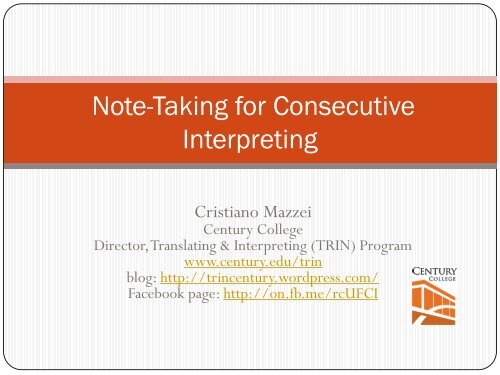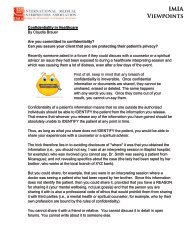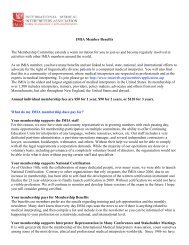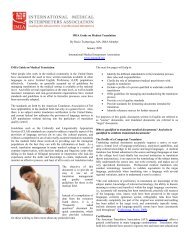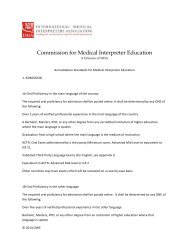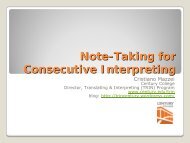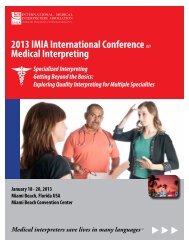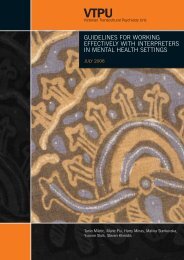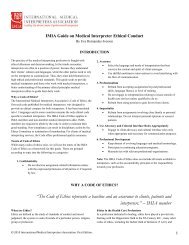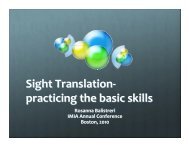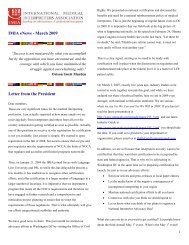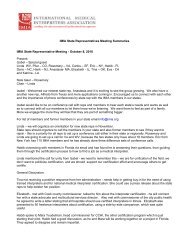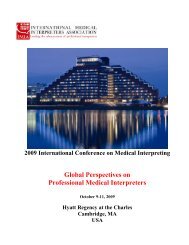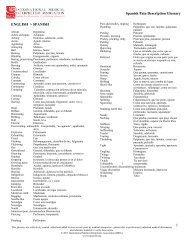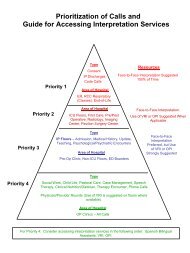Note-Taking for Consecutive Interpreting - IMIA
Note-Taking for Consecutive Interpreting - IMIA
Note-Taking for Consecutive Interpreting - IMIA
Create successful ePaper yourself
Turn your PDF publications into a flip-book with our unique Google optimized e-Paper software.
<strong>Note</strong>-<strong>Taking</strong> <strong>for</strong> <strong>Consecutive</strong><br />
<strong>Interpreting</strong><br />
Cristiano Mazzei<br />
Century College<br />
Director, Translating & <strong>Interpreting</strong> (TRIN) Program<br />
www.century.edu/trin<br />
blog: http://trincentury.wordpress.com/<br />
Facebook page: http://on.fb.me/rcUFCI
Importance of note-taking<br />
• Katharine Allen (51 st ATA Conference, Denver)<br />
◦ Importance of developing note-taking skills in community<br />
interpreting<br />
• so that we’re not interrupting speakers all the time <strong>for</strong> short consecutive<br />
interpretation.<br />
◦ Community interpreting training programs are teaching wouldbe<br />
interpreters to interrupt people all the time<br />
• Sometimes the medical provider is giving a long explanation to the patient<br />
about his/her condition and their plans <strong>for</strong> patient recovery.<br />
◦ If interrupted they might lose track of what they’re saying, etc.
Importance of note-taking<br />
• In court,<br />
• Many interpreters are now using digital recorders in the long<br />
consecutive mode<br />
• Then providing simultaneous interpretation<br />
• However, recorders sometimes fail (technical problems, etc)
<strong>Note</strong>-taking?<br />
• But, long consecutive interpreting with note-taking may not<br />
be the best model all the time<br />
• the distance between the original speech and the interpreted<br />
rendition is too long<br />
• paralinguistic elements (nonverbal communication, intonation, emotional<br />
outbursts, etc) are lost.<br />
• Maybe in these emotionally charged settings, the simultaneous<br />
mode would be the best <strong>for</strong>mat? Thoughts?
Jean-François Rozan (1956)<br />
• 7 principles<br />
• Noting the idea, not the word<br />
• Abbreviation<br />
o Unless a word is short (4-5 letters), interpreters should use an<br />
unambiguous abbreviated <strong>for</strong>m<br />
• Links<br />
• Negation<br />
o OK = agree;<br />
o then “disagree” = OK<br />
• Emphasis<br />
• Verticality<br />
• Shift
<strong>Note</strong>s<br />
54, prices<br />
but<br />
prices rose, although not to<br />
the same extent as income,<br />
no<br />
so<br />
income<br />
pop on “Over the course of 1954,<br />
thus the population’s net<br />
=<br />
income increased.”
Andrew Gillies (2005)<br />
• Macro<br />
• Looking at the bigger picture<br />
• Structure, framework, the way the speech is built up<br />
• Micro-level<br />
• Words, expressions<br />
• <strong>Note</strong>-taking <strong>for</strong> consecutive interpreting<br />
• Skeleton structure of the speech.<br />
• Visual representation of your analysis of the source speech.
<strong>Note</strong>-taking<br />
• Different tasks<br />
• Phase 1: listening and analysis, note-taking, short-term memory<br />
operations, coordination of these tasks<br />
• Phase 2: note-reading, remembering, production<br />
• Difficulties:<br />
• If you’re thinking too much about how to note something, you will listen<br />
less well.<br />
• If your notes are unclear or illegible your production will suffer because<br />
you’ll put too much ef<strong>for</strong>t into reading them.
<strong>Note</strong>-taking<br />
• Dissecting the speech<br />
• Analyzing its structure, progression<br />
• Analyzing the communicative function of different parts of the speech<br />
• Recognizing the main ideas and secondary ones<br />
• Spotting the links between them
Mini Summaries<br />
• To summarize:<br />
• Function and structure of the speech’s parts.<br />
• Not the content!
Mind Maps<br />
• Way of organizing in<strong>for</strong>mation on a piece of paper<br />
• Organic chart<br />
• Words and drawings are connected to one-another on the<br />
page in various ways<br />
• Lines<br />
• Position on the page relative to one another<br />
• How the mind associates and recalls in<strong>for</strong>mation
Mind Maps<br />
• In the long term the idea is to<br />
develop a European high-speed<br />
railway network with Paris at its<br />
centre. A line to the north will<br />
reach Brussels, where it can<br />
branch out to the east to Cologne,<br />
or continue further north to<br />
Amsterdam and later even<br />
Hamburg. To the south-east the<br />
line through Lyon will Enter Italy<br />
through Turin and reach through<br />
Rome and Naples right down to<br />
the toe of Italy. In the south-west<br />
a link up with Spain via Barcelona<br />
and then to Madrid will make it<br />
possible to extend the network<br />
down to Seville.
SOV<br />
• “Who did what to whom?”<br />
• The sentence<br />
• Basic unit of communication<br />
• Subject<br />
• Verb<br />
• Object
SVO<br />
• “Who does what to whom (or to what)?”<br />
S V O O<br />
We… …took stock of… relations… …and the situation<br />
For the purposes of note-taking in consecutive<br />
interpreting an idea is….<br />
SVO
SVO<br />
• On each page<br />
• Two or three sections<br />
• Subject, verb and object<br />
• Diagonally across the page.<br />
• Don’t squeeze more than this onto a page<br />
• Will be harder to read back
SVO Diagonally<br />
• Easier to read back<br />
• Less writing on a page, so ideas stand out<br />
• Visible structure<br />
• Visible at a glance, which is not possible if we note horizontally as we write<br />
normally.<br />
• Eyes move from left to right<br />
• Like a typewriter, always coming back to the left at the end of each idea<br />
• The beginning of each idea<br />
• Is noted furthest to the left, so we see it first<br />
• No syntactic interference<br />
• Something that horizontal notes encourage. That means using the wrong word<br />
order in the target language because you noted something in the source language<br />
order<br />
• Space <strong>for</strong> additions
SVO Diagonally<br />
There<br />
were<br />
developments<br />
we<br />
It<br />
____________________<br />
took stock<br />
_____________________<br />
is<br />
____________________<br />
relations<br />
+ situations<br />
too early
Links<br />
• Links<br />
• Signal the way the speaker wants to listener to relate what is<br />
about to be said to what has been said be<strong>for</strong>e<br />
• Speech<br />
• Ideas<br />
• Links between them
Links<br />
• The economy is struggling. The Central Bank has left interest rates<br />
unchanged.<br />
• The economy is struggling. However, the Central Bank has left interest rates<br />
unchanged.<br />
• The economy is struggling. Consequently, the Central Bank has left interest<br />
rates unchanged.<br />
• Different messages<br />
• Bring ideas into relations with one another<br />
• Provide more in<strong>for</strong>mation about the situation
Links
Links
Parallel Values<br />
• It’s not uncommon <strong>for</strong> speakers to have the same subject<br />
doing many different things.<br />
• By noting the verbs parallel to one another on the page<br />
• Clearly see they have the same subject
Parallel Values<br />
• First, any successful economy needs to con<strong>for</strong>m<br />
to certain basics. It should be an open economy,<br />
willing to let capital and goods move freely. It<br />
needs financial and monetary discipline - the<br />
markets and investors swiftly punish the profligate.<br />
It needs to encourage business and enterprise -<br />
to create an enabling climate <strong>for</strong> entrepreneurs. A<br />
few years ago, people might have stopped there.<br />
But now we can add confidently: the successful<br />
economy also must invest heavily in human<br />
capital, technology and infrastructure. Education is<br />
a top economic as well as social priority. High<br />
levels of unemployment and social exclusion do not<br />
just disfigure society, they waste the national<br />
resource of human talent.
Parallel Values<br />
• Because the French government has cut customs duties.<br />
• Because the French, German and British governments have cut customs duties.
Parallel Values<br />
• Because the French, German and British governments have cut<br />
customs duties, visa fees and administrative charges.
Brackets<br />
• By positioning an element vertically below another<br />
• In brackets<br />
• Clearly identify<br />
• One belongs to the other<br />
• Is subordinate to it within the clause or SVO group<br />
• We can adjust our intonation appropriately
Brackets<br />
• And today? The changes, even since 1973, when Britain<br />
entered the European Economic Community, are<br />
remarkable:
Symbols<br />
• First thing students interpreters ask about<br />
• Knowing a reasonable number of useful symbols can make<br />
our lives easier<br />
• But unimportant when compared to all of what we have read<br />
be<strong>for</strong>e<br />
• If you don’t have a consistent and meaningful note-taking<br />
system<br />
• No symbol is going to help you
Symbols<br />
• Not only a picture<br />
• Short word<br />
• Pair of letters<br />
• Single letter<br />
• The important thing is what it represents<br />
• Concepts not words<br />
• Concepts not words<br />
• They’re not one-to-one translations so they help us avoid source language<br />
interference when we interpret
Symbols<br />
• Clear and unambiguous<br />
• Quick and simple to draw<br />
• More than 3 strokes of the pen is probably two slow.<br />
• Prepared in advance<br />
• DON’T IMPROVISE MID SPEECH<br />
• Consistent<br />
• If E is energy, make sure it stays energy always and find yourself another<br />
symbol <strong>for</strong> environment and economy.<br />
• Organic<br />
• Starting point <strong>for</strong> many other symbols<br />
• Must mean something to you<br />
• Don’t blindly copy symbols you see if they don’t create associations <strong>for</strong> you
Symbols - Organic<br />
• The symbol of the square commonly denotes “country,<br />
nation, land, state”<br />
al<br />
ally<br />
ze<br />
tn<br />
o<br />
national (adjective<br />
nationally<br />
to nationalize<br />
nationalization<br />
national (noun), citizen
Symbols – The Arrow<br />
← Return, come back, reverse, regress<br />
↗ Rise, increase, grow, climb, etc<br />
↘ Fall, decline, slide, slip, drop, shrink<br />
↔ Exchange, relations<br />
→ Lead to, consequence of, there<strong>for</strong>e
Symbols - People
Symbols - Underlining
Where to find symbols?<br />
• Math = + > < % /<br />
• Science E µ t<br />
• Music #<br />
• Text messages L8R R U OK? 2 etc.<br />
• Keyboard % & @ <br />
• Punctuation marks ? ! ( ) " :<br />
• Vehicle registrations D DA UK CH F<br />
• Short words in other<br />
languages: so hi ta ok /<br />
deja / ergo etc / pero<br />
• Currencies $ Y L €<br />
• Periodic table Fe Na Po Ag CO2 CO NO2 H3SO4
Reproduction/ Delivery<br />
• Skills<br />
• Fluency<br />
• Natural intonation<br />
• Engaging your audience<br />
• Using your notes correctly<br />
• “Read” might be misleading<br />
• Interpreters do not read their notes in the usual sense of the word.<br />
• You’re constantly reading ahead of your notes
Reproduction/ Delivery<br />
• Good speakers vary<br />
• Volume<br />
• Speed<br />
• Tone of delivery<br />
• Interpreters will want to do the same<br />
• Based on<br />
• What the speaker said<br />
• Memory<br />
• <strong>Note</strong>s taken
Hybrid Courses (Century College)<br />
• 50% face-to-face<br />
• 50% online (Reflection and Self-Assessment)<br />
• Students post their notes online and reflection<br />
• Take pictures of their notes with their cell phones<br />
• Scan them<br />
• Peer-to-peer feedback<br />
• Videos found on youtube on notetaking <strong>for</strong> consecutive interpreting<br />
AIB (Agrupación de Intérpretes de Barcelona)<br />
• Videos found on<br />
http://www.nationalnetwork<strong>for</strong>interpreting.ac.uk/<br />
EMCI (European Masters in Conference <strong>Interpreting</strong><br />
http://www.emcinterpreting.org/
References<br />
• Rozan, Jean-François. <strong>Note</strong>-taking in <strong>Consecutive</strong> <strong>Interpreting</strong>.<br />
Trans. Andrew Gillies. Tertium. Poland, 2004.<br />
• Gillies, Andrew. <strong>Note</strong>-<strong>Taking</strong> <strong>for</strong> <strong>Consecutive</strong> <strong>Interpreting</strong>: A Short<br />
Course. St. Jerome. 2005<br />
• http://interpreters.free.fr/


